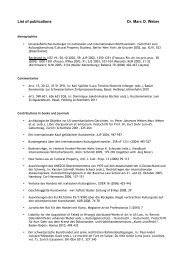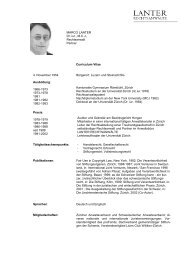Liability for the Acquisition of Faked or Wrongly Attributed Works of ...
Liability for the Acquisition of Faked or Wrongly Attributed Works of ...
Liability for the Acquisition of Faked or Wrongly Attributed Works of ...
You also want an ePaper? Increase the reach of your titles
YUMPU automatically turns print PDFs into web optimized ePapers that Google loves.
F<strong>or</strong>t Sumter by Albert Bierstadt (1830–1902) purchased at a price <strong>of</strong> USD<br />
50’000 from <strong>the</strong> defendant in 1981 had been reattributed in 1986. None <strong>of</strong> <strong>the</strong><br />
parties claimed an au<strong>the</strong>ntication had been made pri<strong>or</strong> to <strong>or</strong> at <strong>the</strong> time <strong>of</strong> sale <strong>of</strong><br />
<strong>the</strong> painting. The reattribution was sourced to one article published in 1986 by an<br />
art hist<strong>or</strong>ian and its subsequent acceptance by art experts at <strong>the</strong> time <strong>of</strong> suit in<br />
1987. 91 The court, ra<strong>the</strong>r than <strong>the</strong> parties, recast <strong>the</strong> lawsuit <strong>f<strong>or</strong></strong> rescission based<br />
upon mutual mistake as a U.C.C. action, contending that no mutual mistake<br />
could have occurred since both parties believed <strong>the</strong> prevailing market attribution<br />
to Bierstadt was c<strong>or</strong>rect. The plaintiffs were, acc<strong>or</strong>ding to <strong>the</strong> court, not rescinding<br />
<strong>f<strong>or</strong></strong> mistake, but were revoking acceptance. The breach occurred in 1981 at<br />
<strong>the</strong> time <strong>of</strong> delivery under U.C.C. § 2-725(2), irrespective <strong>of</strong> when <strong>the</strong> plaintiffs<br />
gained knowledge <strong>of</strong> <strong>the</strong> breach. The district court held that <strong>the</strong> contract claims<br />
were time-barred since <strong>the</strong> suit was filed m<strong>or</strong>e than four years after <strong>the</strong> delivery<br />
date. Without discussing <strong>the</strong> merits <strong>of</strong> <strong>the</strong> claim, <strong>the</strong> court dismissed <strong>the</strong> plaintiffs’<br />
argument that a discovery rule should apply; 92 U.C.C. § 2-725(2) precluded<br />
<strong>the</strong> action and state law did not o<strong>the</strong>rwise allow it.<br />
IX. Conclusion<br />
1. Case law illustrates <strong>the</strong> inability <strong>of</strong> <strong>the</strong> legal system to provide a definitive<br />
determination <strong>of</strong> au<strong>the</strong>nticity <strong>of</strong> w<strong>or</strong>ks <strong>of</strong> art.<br />
2. An implied warranty <strong>of</strong> merchantability applies to art and can be claimed under<br />
U.C.C. § 2-314. If <strong>the</strong> parties to a contract both make a mistake about<br />
material facts in existence at <strong>the</strong> time <strong>of</strong> contracting, <strong>the</strong> doctrine <strong>of</strong> mutual<br />
mistake allows rescission <strong>of</strong> <strong>the</strong> contract.<br />
3. Three potential solutions exist with regard to <strong>the</strong> rescission <strong>of</strong> <strong>the</strong> contract <strong>of</strong><br />
sale: (1) When <strong>the</strong> parties are mistaken as to an imp<strong>or</strong>tant quality <strong>of</strong> a specified<br />
good and <strong>the</strong> lack <strong>of</strong> this quality is disadvantageous to <strong>the</strong> party challenging<br />
<strong>the</strong> agreement, <strong>the</strong>n both parties should have <strong>the</strong> right to challenge<br />
<strong>the</strong> agreement. (2) Only <strong>the</strong> party that was unintentionally <strong>or</strong> willfully misled<br />
by <strong>the</strong> counter-party should have <strong>the</strong> right <strong>of</strong> challenge. (3) When <strong>the</strong> parties<br />
91 In general, a one-year period is not a sufficient time <strong>f<strong>or</strong></strong> a reattribution to garner<br />
consensus among art experts; it barely allows time <strong>f<strong>or</strong></strong> scholarly public debate <strong>or</strong><br />
published response to <strong>the</strong> new attribution; see Darraby (supra note 17), § 4:31, 249,<br />
footnote 2.<br />
92 The only case involving an au<strong>the</strong>ntication issue in which <strong>the</strong> discovery rule under U.C.C.<br />
§ 2-725(2) was applied, is Balog v. Center Art Gallery-Hawaii, Inc., supra note 15.<br />
432





